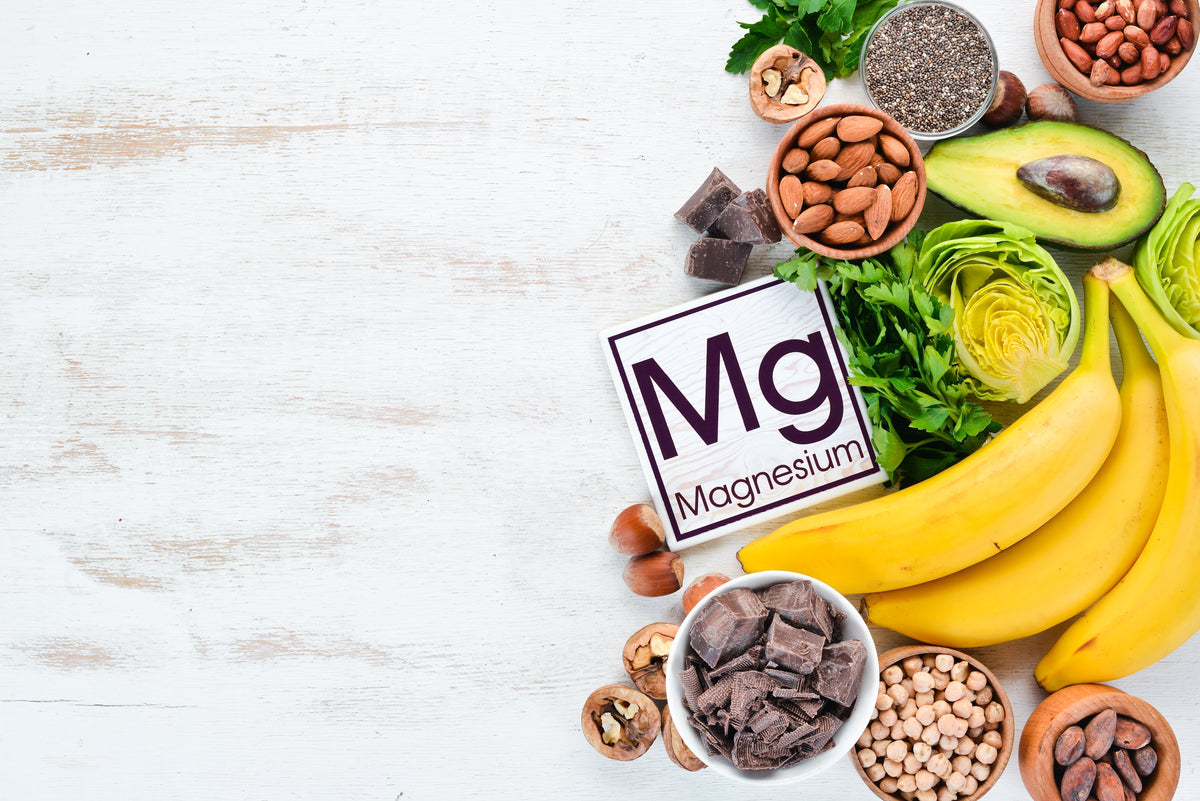Which Magnesium Type is Best Suited for Your Goals?

Magnesium powers more than 300 biochemical reactions—sleep quality, stress resilience, muscle recovery, energy production, heart rhythm, and cognitive performance. But supplements aren’t one-size-fits-all. The form you choose changes where magnesium goes and how it feels: glycinate for calm and sleep, citrate for digestion and energy, L-threonate for brain clarity—plus malate, taurate, orotate, chloride (topical), sulfate (Epsom), and oxide for niche jobs. This expert guide explains each type, compares bioavailability and best uses, and shows you how to match a form to your goal (sleep, energy, cramps, focus). You’ll also get dosing guardrails, stack ideas, and a PAA-informed FAQ for quick answers. Ready to personalise your routine? Explore practitioner-grade options in our Magnesium Supplements collection.
Why Magnesium Type Matters (Bioavailability, Target Tissues, Outcomes)

“Magnesium” on a label is shorthand for magnesium bound to another compound, usually called an anion. This bond changes how magnesium behaves once inside the body—it affects solubility, absorption rate, bioavailability, and where it ends up in your tissues. The core metal is the same, but its partner molecule determines whether it acts like a gentle relaxant, a digestive aid, or a cognitive enhancer.
Think of it as packaging: the same nutrient, wrapped differently for different delivery routes. Some forms, known as chelates (where magnesium is joined to amino acids like glycine or taurine), tend to be better tolerated and more completely absorbed. Others—such as oxides or carbonates—offer a high amount of elemental magnesium but are poorly absorbed, meaning much of what you swallow simply passes through.
That’s why magnesium glycinate feels different from magnesium citrate, even if both supply the same number of milligrams. Glycinate, coupled with the amino acid glycine, travels smoothly through the gut and into the bloodstream, producing a calming effect on the nervous system and supporting deep sleep. Citrate, bound to citric acid, dissolves readily in water and draws fluid into the intestines, making it helpful for digestion, energy metabolism, and regularity.
If your goal is mental clarity or cognitive performance, magnesium L-threonate is uniquely engineered to cross the blood–brain barrier. Research suggests it increases magnesium concentrations in brain tissue and supports synaptic plasticity—the adaptability that underlies learning and memory.
This article translates the underlying biochemistry into practical outcomes: which form to take, when to take it, and how to combine types safely. You’ll start with an at-a-glance table comparing absorption and purpose, then explore the “big three” in detail—glycinate, citrate, and L-threonate—before a concise overview of other useful forms such as malate, taurate, orotate, and topical chloride.
Finally, you’ll find links to our evidence-led pieces on magnesium for migraines and magnesium for muscle & sleep to help you drill into specific use-cases.
Types of Magnesium — Quick Comparison
| Form | Absorption | Best For | Key Notes |
|---|---|---|---|
| Glycinate | Excellent | Sleep, stress, anxiety, PMS, tight muscles | Glycine chelate → calming; gentle on gut; great nightly use |
| Citrate | Good | Constipation, digestion, low energy | Osmotic effect; supports Krebs cycle; morning use |
| L-Threonate | Brain-targeted | Cognition, memory, study focus, mental fatigue | Crosses BBB; supports synaptic plasticity |
| Malate | High | Daytime energy, fibromyalgia-type muscle pain | Malic acid (energy pathway) — non-sedating |
| Taurate | Good | Heart rhythm, calm focus | With taurine; cardio-supportive profile |
| Orotate | Moderate | Athletic recovery, cardiovascular niche | Orotic acid carrier; often premium priced |
| Chloride (topical) | Transdermal | Local cramps, DOMS, sensitive gut | Sprays/lotions; pairs with oral forms |
| Sulfate (Epsom) | Topical | Bath relaxation, soreness, wind-down | Soak 15–20 min; great rest ritual |
| Oxide | Low | Short-term constipation only | High elemental %; poor systemic absorption |
Magnesium Glycinate — Best for Sleep & Stress (High Bioavailability, Gentle on Gut)
Magnesium glycinate is elemental magnesium bound to the amino acid glycine. Glycine is an inhibitory neurotransmitter: it supports parasympathetic tone (“rest-and-digest”) and helps the brain wind down at night. The chelated structure improves stability in the gut and facilitates transport across the intestinal wall, so you get more magnesium “on board” with fewer GI side effects than you might see with oxide or high-dose citrate.
Clinically, glycinate is the go-to for insomnia, stress reactivity, restless muscles, jaw clenching, and PMS-related sleep disruption. It’s also helpful for people who can’t tolerate laxative effects. Most adults do well with 200–400 mg elemental magnesium in the evening, 45–90 minutes before bed. If you already use a protein-rich dinner, glycinate layers nicely because glycine complements collagen and supports sleep architecture. For anxious “wired-and-tired” nights, consider pairing glycinate with breath work, a dark room, and limiting late blue light.
Magnesium Citrate — Best for Digestion & Daytime Energy
Magnesium citrate binds magnesium to citric acid, increasing water solubility and intestinal absorption. It also creates a mild osmotic effect—pulling water into the bowel—which promotes regularity without harsh stimulants. That makes citrate a smart choice for people with sluggish bowels, travel-related constipation, or low-fiber days.
Metabolically, the citrate moiety participates in the Krebs (citric acid) cycle—the cell’s ATP engine—so many users report cleaner daytime energy when they switch from oxide to citrate. It’s not a stimulant; it simply supports efficient energy production. Take citrate with breakfast or lunch to avoid late-evening bowel activity. Dose gently: 150–300 mg elemental magnesium to start, adjusting by response. If stools loosen, reduce the dose or split across meals.
Magnesium L-Threonate — Best for Brain Health, Focus & Learning
L-Threonate is a unique carrier that improves magnesium transport into the brain. Animal and early human data suggest it raises cerebrospinal magnesium and supports synaptic plasticity—the neural adaptability behind learning and memory. Users most often describe improved mental clarity, less “brain fog,” smoother task-switching, and better recall after 4–6 weeks of consistent use.
Typical protocols use 100–200 mg elemental magnesium from L-threonate twice daily (afternoon and evening). It’s generally non-sedating and pairs well with glycinate for “sharp by day, calm by night.” If headaches or migraines are part of your picture, read our evidence summary: Magnesium for Migraines.
Other Forms (When & Why to Use Them)
Magnesium Malate — Daytime Energy & Muscle Comfort
Malate (from malic acid) feeds the energy cycle and is gently activating—handy for daytime use, muscle aches, and fibromyalgia-type discomfort. Non-sedating alternative to glycinate for people who feel “flat” in the mornings.
Magnesium Taurate — Calm Heart, Calm Mind
Bound to taurine (an amino sulfonic acid involved in cardiac function and GABA modulation), taurate is a good pick for calm focus with a heart-friendly profile. Often used in multi-mineral formulas aimed at cardiovascular wellness.
Magnesium Orotate — Performance Niche
Orotic acid may aid nucleotide synthesis; athletes sometimes choose orotate for recovery, though it’s usually more expensive. Consider only if you’ve already covered basics (dietary magnesium + a core supplement).
Magnesium Chloride (Topical) — Local Cramps, DOMS
Sprays, oils and lotions deliver transdermal magnesium to sore areas with minimal GI impact. Great adjunct for restless legs, post-workout calves, or bedtime foot rubs. Patch test if you have sensitive skin.
Magnesium Sulfate (Epsom Salt) — Bath Relaxation
Classic 15–20 minute warm bath ritual for stress down-regulation and muscle ease. Blend with a small amount of Celtic sea salt for a broader mineral feel. Hydrate before/after soaking.
Magnesium Oxide — Short-Term Only
High elemental percentage but low systemic absorption. Useful as a short-term laxative; not ideal for daily repletion.
How to Choose (and Combine) Magnesium Forms
- Sleep & anxiety: Glycinate 200–400 mg nightly. Add L-threonate earlier if focus is also a goal.
- Constipation + low energy: Citrate 150–300 mg with breakfast. Adjust by stool response.
- Brain clarity: L-threonate split dose (afternoon/evening). Layer glycinate at bedtime if sleep is light.
- Muscle recovery: Oral glycinate or malate + topical chloride to target hotspots.
- PMS & cramps: Glycinate (calm) ± taurate (steady focus), daily through the luteal phase.
Magnesium FAQs
What is the best kind of magnesium to take?
It depends on your goal. Glycinate for sleep/stress, Citrate for digestion/energy, L-threonate for brain health. Malate (daytime energy) and taurate (calm focus/heart) are solid backups.
Do different types of magnesium do different things?
Yes—the anion (glycine, citrate, threonate, etc.) changes absorption and tissue targeting. That’s why forms feel different even at the same elemental dose.
Which is better for sleep and anxiety: magnesium citrate or glycinate?
Glycinate. It’s calming and gentler on the gut. Use citrate in the morning if you also want bowel support.
Is it OK to take magnesium every night?
For healthy adults, nightly glycinate (200–400 mg elemental) is commonly used. If you’re pregnant, have kidney disease, or take specific medicines, check with your clinician first.
What vitamins or meds should not be taken with magnesium?
Space magnesium at least 2 hours away from levothyroxine and some antibiotics (e.g., tetracyclines, quinolones) to avoid absorption interference. Your pharmacist can advise on specifics.
What’s the downside of magnesium glycinate?
It’s well tolerated; downsides are rare and usually dose-related (excessive sedation for some, if dosing high). Start lower and titrate.
Which magnesium is best for leg cramps and restless legs?
Combine oral glycinate or malate with topical chloride on calves/feet before bed. Ensure hydration and potassium intake are adequate.
Can magnesium help with migraines?
Evidence supports magnesium (often glycinate, citrate, or L-threonate) as part of a migraine strategy. See our guide: Magnesium for Migraines.
What are signs of magnesium deficiency?
Fatigue, poor sleep, muscle twitches/cramps, headaches, low stress tolerance, constipation. Blood magnesium isn’t always reflective of tissue levels.
Can I take vitamin D and magnesium together?
Yes. Magnesium acts as a co-factor for vitamin D metabolism. Many combine them—just mind total doses and take with food if your stomach is sensitive.
Bottom Line: Match the Form to the Job
Magnesium is a category, not a single experience. Choose glycinate when you need calm, deeper sleep, and fewer nighttime wake-ups. Choose citrate when you want digestive regularity and steadier daytime energy. Choose L-threonate when sharp focus and mental clarity matter most. Add malate for daytime pep, taurate for calm focus, chloride (topical) for local cramps, and Epsom baths for rapid wind-down.
Start low, be consistent, and measure results by how you sleep, move, and think—not just the label dose. When you’re ready to build a clean, effective routine, shop our curated Magnesium collection and pair this guide with our deep dives on muscle & sleep and migraines.
About this article
- Magnesium — Fact Sheet for Health Professionals — National Institutes of Health (NIH) (Mar 2024)
- Scientific Opinion on Dietary Reference Values for magnesium — European Food Safety Authority (EFSA) (Jan 2015)
-
15 April 2025Notes:Article published


